Which of the following option best describes the gravity explained by two scientists?
B is the best option. According to scientist 1 “Each particle of matter attracts every other particle (for instance, the particles of "Earth" and the particles of "you") with a force that is directly proportional to the product of their masses and inversely proportional to the square of the distance between them.” Similarly, scientist 2 says that “Gravity is not a force but it is a distortion of space (or more precisely, spacetime) caused by the presence of matter or energy.” Hence, both statements are true, so this is the correct choice. A is incorrect because neither gravity is inversely proportional to the product of masses according to scientist 1, nor scientist 2 describes gravity as a force. C is incorrect because scientist 2 explains that how light rays are affected by gravity, even they have no mass. Scientist 1 talks about proportionality of gravity with masses, so both the statements are not true. D is incorrect because scientist 1 says that gravity is inversely proportional to the square of distance between two objects. E is incorrect because scientist 2 does not explain any relation of gravity with mass.
Gravity is directly proportional to the product of masses of the two objects. Which of the following statement weakens this argument?
A is the best option. Light rays are coming to the earth due to gravity according to the scientist 2. The photons have no mass still they are affected by gravity, so this statement weakens the argument made by scientist 1 that gravity is directly proportional to the product of the masses of two objects. B, C and D are incorrect as they are supporting the argument. As we and any other object has mass, so the gravitational force is acting on every object including us. Therefore, we do not float, neither an object stays in the air. Similarly, it is easier to lift a lighter object as compared to the heavier one because of the less gravitational force acting on it. E is incorrect as both B and C described above strengthens the arguments instead of weakening it.
Passage 5 - Allergic diseases have a large impact on human health globally, with 10–30% of the population affected by allergic rhinitis and more than 300 million affected by asthma. Pollen from grass species, which are highly allergenic and occur worldwide, elicits allergic responses in 20% of the general population and 40% of atopic individuals. Scientists examined the effects of elevated levels of two greenhouse gases, carbon dioxide (CO2), a growth and reproductive stimulator of plants, and ozone (O3), a repressor, on pollen and allergen production in Timothy grass (Phleum pratense L.) Experiment 1 - Researchers treated Timothy grass under two conditions. First, they used 30 ppb ambient level of ozone and observed the change in pollen production by the plant. Then, they placed the same plant by elevating the level of ozone to 80 ppb and observed the behavior of the plant with respect to pollen production. For both the experiments level of Carbon dioxide was the same, only ozone levels were altered. Following graph shows what was observed by the researchers under both the conditions.
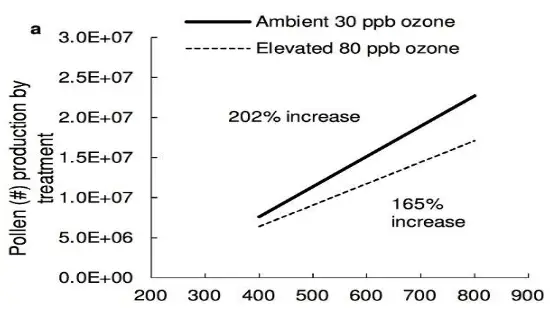
Experiment 2 - The same plant was then observed for any change in the allergen production. The findings of the researchers are depicted in the chart below. Here, the dotted line shows elevated level whereas solid line reflects ambient level of ozone gas.
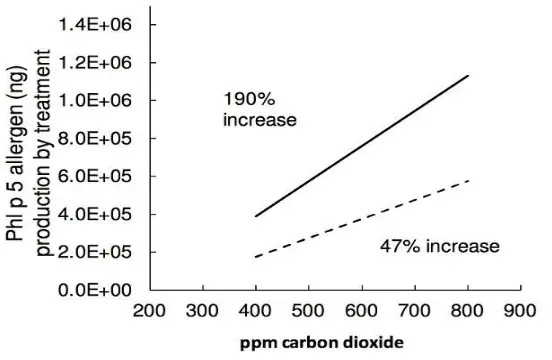
Which of the following statement is true about the experiment 1?
E is the best option. You can see in the graph that pollen production decreases from 202% to 165% when elevated level of ozone is used. So, we can say that B is the correct option. There is another correct option besides B and that is D. Under ambient level the pollen production by the plant is 202% and is 165% under elevated levels. So, we can conclude that both B and D are correct. A is incorrect because pollen production decreases under ambient level of ozone. B is not the best option as besides B, D is also correct. C is incorrect because option A does not reflect the finding of the experiment 1. D is incorrect because it is not the single option among all the choices which is correct.
How much pollen production reduces when ambient level of ozone is replaced by the elevated level?
A is the best option. Ambient level of ozone increases the pollen production by 202%, whereas elevated level increases by 165%. So, percentage of pollen reduced when ambient ozone is replaced by elevated ozone level is 202%-165%=37%. B and C are incorrect as they are the percentage increase for the ambient and elevated level. D and E are incorrect as they do not reflect the percentage decrease in the pollen production.
Which of the following statement is the best conclusion for the Experiment 1?
B is the best option. As, we know that pollens are the cause of many allergic diseases and the graph of the experiment 1 shows that pollen production increases significantly when Timothy grass is experimented under ambient and elevated levels of ozone. Therefore, B is the best conclusion for the experiment 1. A is incorrect because pollen production increases for both ambient and elevated levels of ozone. C is incorrect because graph does not show that elevated level decreases the overall pollen production but it reflects that pollen production with respect to ambient level is slightly decreased when elevated level is used. D is incorrect because pollen production increases under both levels of ozone. E is incorrect because both C and D are incorrect.
Which of the following statements in true about the experiment 2?
D is the best option. In the graph of the experiment 2, we can see that allergen production increases overall regardless of any level of ozone used. There is 190% increase for the ambient level and 47% increase under elevated level. A is incorrect because experiment 2 is about the allergen production, not the pollen production as you can see that y-axis is labelled for the allergens. B is incorrect because elevated level does not decrease the allergen production but only has low allergens produced as compared to ambient level. C is incorrect because the graph is about allergen production, not the pollen production. E is incorrect because both level of ozone increase the allergen production.
How much allergen production does elevated level of ozone produces less than the ambient level?
D is the best option. Ambient level increases allergen production by 190% and elevated level 47%. So, percentage of allergen production that ambient level produces more than elevated level is 190%-47%=143%. A is incorrect as it is the percentage increase in allergens by ambient level. B is incorrect as it is the increases production of pollens by ambient level. C is incorrect because it is the percentage increase in allergen production under elevated level. E is incorrect as it does not reflect the difference in percentage among two ozone treatments.
Which of the following statement best reflects the conclusion drawn from experiment 2?
C is the best option. The graph depicts the increase in allergen levels for both levels of ozone gas. A is incorrect because graph of the experiment 2 is about allergen production, not pollen production. B is incorrect because the overall allergen production increases regardless of any level of ozone gas. Only the allergen production under elevated level is lower as compared to ambient one. D is incorrect because allergen production increases in both the cases. E is incorrect because the graph clearly reflects increase in allergen production under both level of ozone gas.
Passage 6 - Occasional fog is a critical water source utilized by plants and animals in the Namib Desert. Fog basking beetles (Onymacris unguicularis, Tenebrionidae) and Namib dune bushman grass (Stipagrostris sabulicola, Poaceae) collect water directly from the fog. While the beetles position themselves optimally for fog water collection on dune ridges, the grass occurs predominantly at the dune base where less fog water is available. Experiment 1 - Scientists placed beetles, metal wires and grass side-by-side in a fog chamber and measured the amount of water they collect over time. Following figure shows fog water collection (mean plus standard deviation) per mm2 of the experimental objects upper surface area.
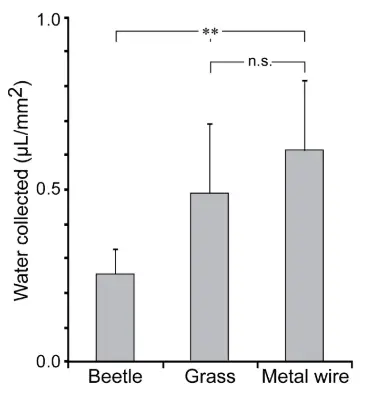
Experiment 2 The water run-off dynamics of beetles and grass proved to be very different. Amount of water collected by beetles (black line, N = 12) and grass (green line, N = 12) exposed to fog in intervals from zero to 120 minutes with 20-minute increments (mean ± SD).
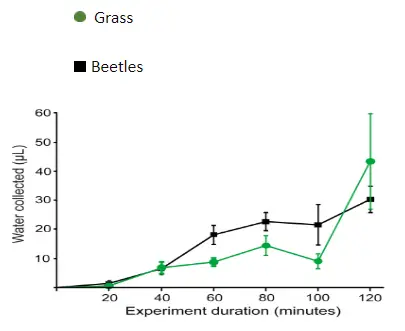
Experiment 1 shows that the water collected by beetles was
A is the best option. We can see in the experiment 1, that beetles collect the lowest water. When we measure their bar chart with respect to y-axis, we come to know that they collected less than 0.3 µl/mm2 water. B is incorrect because it is the water collected by the grass. C is incorrect because it is the water collected by the metal wires. D is incorrect because beetles do not collect 0.1 µl/mm2 water. E is incorrect because A is the best answer to the above question.
Which of the following is the best conclusion for the Experiment 1?
D is the best option. We know that all the three objects were placed in the container for the same time and same surface area was used. Grass eventually collected more water than beetles over time. This shows that the rate of grass to collect water with time is higher than the beetles. A is incorrect because the experiment does not show that beetles need more water. B is incorrect because the graph does not depict that the three objects collect water based upon their needs. Metal wires collect the most water which just shows that it’s rate of water collection is faster than the other two objects. C is incorrect because the same surface area for the three objects was used in the experiment. E is incorrect because A is not the best option.
Experiment 2 shows that till the fourth interval water collected
E is the best option. The graph clearly reflects that till the fourth interval the water collected by beetles is higher than the grass, so, B is correct. D is also correct as water collected by grass is lower in the fourth intervals than beetles, therefore, we can say that both B and D are the correct options. A is incorrect because water collected by beetles and the grass is not same in the fourth interval. B is not the best option because besides B, D is also true. C is incorrect because the first four intervals do not show higher water collection by grass. D is incorrect because besides D, B is also correct.
When do the beetles and the grass collect the equal amount of water?
C is the best option. The chart shows that in 40 minutes both the objects collect the same amount of water which is less than 10µL. A is incorrect because in zero minutes both do not collect any amount of water. B is incorrect because in 20 minutes water collection by beetles is slightly higher than the grass. D is incorrect because in 60 minutes, water collection by beetles is significantly higher than the grass. E is incorrect because in 120 minutes grass collects more water than the beetles.
During which time does the grass collect comparatively less water than the previous interval?
E is the best option as the chart shows that during 80 to 100 minutes, water collection declines. In 100 minutes, it collects the lesser water as compared to the water collected in 80 minutes. Here, we will compare the water collection as compared to the previous intervals of the grass, not the beetles and the grass. A is incorrect because grass collects more water in 120 minutes than the past. B, C and D are incorrect because water collection by grass continuously increases during these times and is higher than the previous time.
Which of the following statements best concludes the second experiment of the study?
D is the best option. We can see the chart in the second experiment which shows that during certain time intervals beetles collect more water than the grass and vice versa. So, we can conclude that water collection depends on time these two objects are placed in the container. A and B are incorrect because the water collection fluctuates between the beetles and the grass and depends on time. C is incorrect because water collection is not the same with time for both the experimental objects, but it constantly fluctuates. E is incorrect because D is the best option which better concludes the experiment 2.
Passage 7 - The increasing availability of food supplements, aggressive media advertising, and common beliefs that these substances have only positive effects on health and sport performance indicate a need for continuous monitoring of this phenomenon. Scientists conducted a study to investigate the habits and beliefs related to diet supplementation among medical, health professional, and other university/high school students by means of a cross-sectional anonymous survey online. Study 1 - The following bar chart shows number of people telling about the adverse reactions of the supplements they faced.
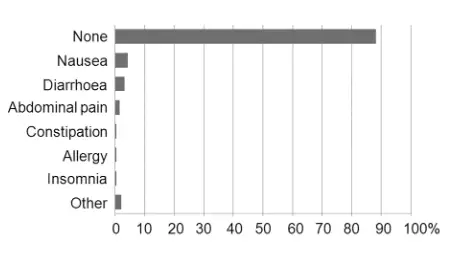
Study 2 - Researchers asked the participants about the type of supplements they take. The following bar chart shows the responses from the participants.
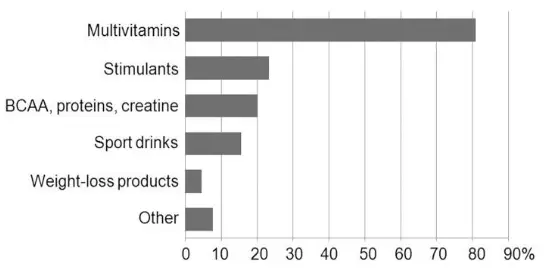
Study 3 - Researchers investigated total 705 people about their beliefs regarding supplements. The response of the people with respect to their reasons of consuming supplements are listed in the table below.
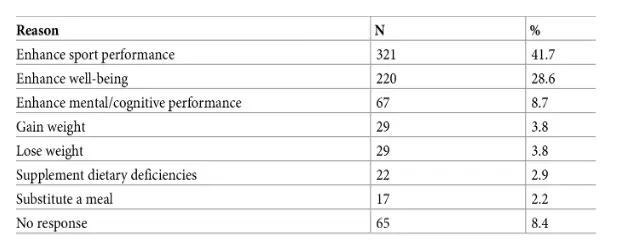
Which of the following statement best describes the finding from the study 1?
B is the best option. The chart of the first study’s findings shows that majority of the people like close to 90% said that multi vitamins have no effect on their health. A is incorrect because only a small percentage of people said that multi vitamins have adverse effects on health. C is incorrect because the study is about multi vitamins and no other factors were investigated. All the people who responded were talking in the context of multi vitamins. D is incorrect because most people who think that multi vitamins have negative effects selected nausea. E is incorrect because D is not the correct option.
Which of the following is more likely to be reported by people who face negative consequence of the supplements according to this study?
D is the best option. The chart shows that people who complain about the adverse reactions, selected nausea the most. So, people are more likely to face nausea among other consequences when they consume multi vitamins. A is incorrect because only few people reported that they got allergy when they consumed supplements. B is incorrect because diarrhea is the second most selected consequence after nausea reported by people. C is incorrect because other consequences are not the most selected answer by people who faced adverse reactions of supplements according to the chart. E is incorrect because although no effect is selected by the majority of the people, but this question is about the people who faced adverse reactions. Among the people who faced adverse reactions of supplements selected nausea a major consequence.
According to the study 3, majority of the people consume supplements so that
B is the best option. The table depicts that majority of people consume supplements to do better in sports. Since, sports are synonymous to physical activity, so B is the best option. A is incorrect as although significantly higher number of people chose enhanced well being as a major reason behind their belief in supplements, however, their number was less than those who think that supplements enhance sport performance. C is incorrect because smaller percentage of people eat multi vitamins to overcome their dietary deficiencies than those who eat to do better in sports. D is incorrect because people who eat supplements for sports outclass those in numbers who eat for improved mental performance. E is incorrect because more people opted for increased performance in sports than substitution of a meal.
Based on the study 1, if you consume multivitamins you are least likely to face
D is the best option. In the chart of the study 1, very few people chose insomnia as a consequence of eat supplements. So, it can be concluded that if you will eat supplement, then it is least likely that you will face insomnia. A and B are incorrect because significantly higher number of people reported diarrhea and nausea as an adverse effect. C is incorrect because it is more likely that you will not face any reaction as majority of the people selected this option. E is incorrect as insomnia is selected by very few people as compared to abdominal pain.
Which one of the following statements best describes the finding from study 2 and study 3 regarding sports?
C is the best option. In study 2, fewer people selected sports drinks when they were asked the type of supplements they eat. Similarly, in study 3, majority of people said that they consume supplements to enhance their sports performance. Combining these facts from both the studies, we come to know that people who said that they consume other supplements like multi vitamins, protein etc. in study 2, also do it for the purpose of enhancing their sports performance and this is reflected in study 3. So, C is the best option. A is incorrect because people who selected sports drink in study 2 are lesser than those who said that they eat supplements to enhance their sports performance in study 3. This means all the people who consume sports drinks selected sports in the study 3 as their reason. B is incorrect because satisfaction is not measured in the either study. D is incorrect because it is not clear in the study that people who consume only multivitamins have selected the sports as their reason. There may be people from other category of supplements too who selected sports as their reason in the study 3. E is incorrect because D is not true.
Which of the following supplements is more likely to be consumed by the people who said that they eat supplements to enhance their well-being?
E is the best option. Since most people selected multivitamins as kind of supplements they eat in study 2, therefore, it is more likely that people who selected enhanced well being in the study 3 eat multivitamins. A is incorrect because fewer people said that they eat stimulants in study 2 are lesser than those who selected multivitamins. So, it means that the people who eat supplements to enhance their well being are more likely to eat multivitamins than stimulants. B, is incorrect because fewer people selected proteins as type of supplement they eat than multivitamins. C is incorrect because there is a greater probability that people who eat weight loss supplements eat them for the purpose of losing weight only. D is incorrect because there is a greater probability that people who consume sport drinks selected the reason enhancement of sport performance in study 3.